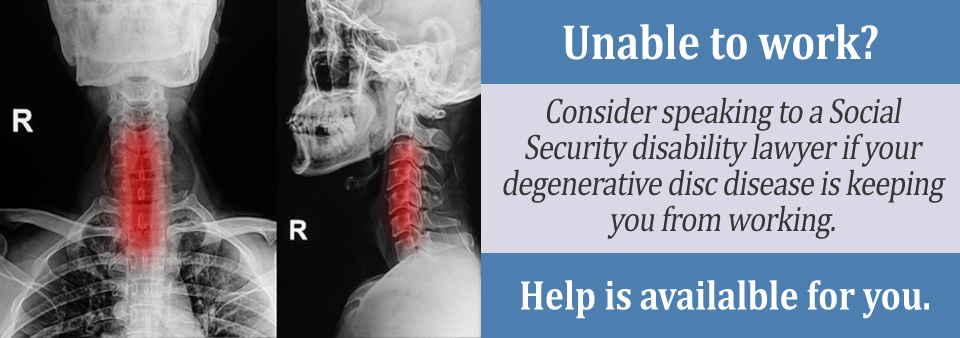Degenerative Disc Disease, also referred to as DDD, is one of the most common reasons for back and neck pain. In fact, back pain causes more disability than any other condition, sending nearly 13 million people to see their doctor each year.
If you have been diagnosed with Degenerative Disc Disease that severely impacts your everyday life and prevents you from earning a gainful living, there could be financial help available to you.
The Social Security Disability Insurance (SSDI) program was created to assist those who have become disabled due to a condition such as DDD.
What Exactly Is Degenerative Disc Disease?
Your back is made up of a column of bones called vertebrae. In between each of these bones are soft, spongy spinal discs. These water-filled discs act as “shock absorbers” to the bones of the spine, allowing you to bend, twist, jump, and move.
As we age, the discs naturally begin to lose some of their water content. As they dry out, they become more hardened and rigid. Over time, the discs start to shrink, and as a result, they provide less of a cushion for the vertebrae.
Without a cushion, the bones begin to rub against one another and can cause bumps on the bone, called bone spurs. In some cases, enough pressure is placed on the discs that small cracks occur and the material in the discs can seep out, which is called a herniated disc.
Degenerative Disc Disease, also sometimes called spondylosis, can sound alarming. However, the name is a bit misleading. DDD is not actually a disease, but a condition that occurs naturally as we age.
While it’s possible to be diagnosed with Degenerative Disc Disease as early as 20 years old, the majority of people affected are in their 40s and 50s. It is possible that DDD can worsen over time, but it’s not considered a progressive disease. In fact, many people begin to feel some relief from DDD as they age.
Unlike other tissues of the body, the spinal discs have a very low blood supply. Therefore, once they become damaged your body has a tough time repairing them naturally.
There is no real cure for DDD. Treatments are usually focused on controlling the pain and may include exercise, physical therapy, lifestyle changes, and in severe cases, surgery.

What Can I Expect?
There are a range of symptoms that can be expected when you have Degenerative Disc Disease, and they all might affect your ability to work differently.
Since DDD occurs as a natural part of the aging process, the Social Security Administration will only consider awarding benefits for more advanced, severe cases in which symptoms are present for at least one year. Here are some symptoms of DDD that might qualify you for disability benefits.
- Nerves run along your spine and can sometimes get compressed, or damaged, as a result of advanced DDD. Pain or numbness that travels to other parts of the body indicates that there may be nerve involvement, also known as radiculopathy. If you experience pain or tingling when you turn your head, use your hands, or walk, it is possible that you may qualify for social security benefits.
- Several membranes protect the nerves around the spinal cord. As DDD progresses, these layers may become inflamed (which his known as arachnoiditis). You may experience severe stinging or shooting pain, muscle spasms or twitching, or issues with your bladder or bowels.
- In some cases of DDD, the spinal cord becomes compressed. This condition is called stenosis. Stenosis can cause pain and weakness in your arms and legs, in some cases resulting in your need for a cane, walker, or crutches.
Any of the above complications of Degenerative Disc Disease may make it difficult to continue working at the capacity you are used to. Many people with DDD have difficulty standing or sitting for extended periods of time. Of course, most jobs require this, so you may qualify for social security benefits.
Do I Qualify for Benefits?
As a general rule, securing Social Security benefits for Degenerative Disc Disease can be a challenge. Since DDD is a normal part of the aging process and since the symptoms of DDD often come and go, your medical records must show that you suffer from a severe case.
Additionally, your condition must be expected to last for at least 12 months, which is often not the case with DDD. However, for some people, DDD is extremely debilitating and painful, and it is these more advanced cases that are more likely to qualify for help.
What Information Will I Need to Provide?
When applying for Social Security, you may be asked to provide the following:
- Confirmation of your diagnosis of DDD from at least one MD, preferably one that specializes in bones, such as an orthopedist.
- Physician notes discussing your symptoms, limitations, and long-term prognosis.
- X-rays, MRIs, or CAT scans are critical to provide, as well as your doctor’s interpretation of these images.
- Records from other practitioners that are assisting you with your condition, such as a Physical Therapist or Psychologist.
- As a general rule, the Social Security Administration does not consider the opinions of chiropractors or alternative therapists.
Building an ongoing relationship with your doctor is critical. The more medical evidence that you have, the higher your chances of approval for SSDI benefits for DDD.
What’s Next?
If you have been diagnosed with Degenerative Disc Disease and you believe that you may qualify for Social Security benefits, you should contact a disability advocate or lawyer in your area.
Pain can make it difficult to take care of yourself, not to mention the many other responsibilities that you have. A qualified attorney can help guide you in the right direction when navigating the Social Security application process.